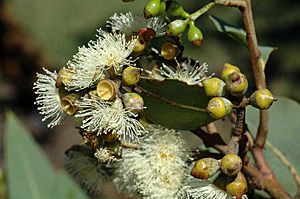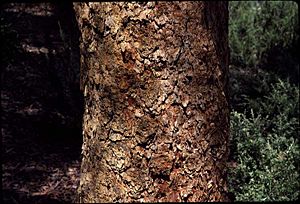Corymbia peltata facts for kids
Quick facts for kids Yellowjacket |
|
|---|---|
 |
|
| Flower buds and flowers of Corymbia peltata | |
| Scientific classification | |
| Genus: |
Corymbia
|
| Species: |
peltata
|
| Synonyms | |
The Corymbia peltata, also known as the yellowjacket or rustyjacket, is a special type of tree. It is found only in Queensland, Australia. This tree gets its name from its unique bark. It has rough, puzzle-piece-like bark on its trunk and big branches. Higher up, the bark is smooth and yellowish.
The Yellowjacket tree has mostly young, egg-shaped leaves. Its flowers are white and grow in groups of seven. After the flowers, it produces fruit that looks like a barrel or an urn.
Contents
What Does the Yellowjacket Tree Look Like?
The Yellowjacket tree is usually small to medium-sized. It typically grows about 10 meters (33 feet) tall. Sometimes, it can reach up to 20 meters (66 feet). This tree has a special woody swelling at its base called a lignotuber. This helps it regrow after fires.
Its bark is quite interesting. On the main trunk and larger branches, it's rough and looks like a tessellated pattern, like small blocks fitted together. Higher up, the bark is smooth and has a yellowish color.
Young Yellowjacket plants have round or egg-shaped leaves. These leaves are quite large, about 8 to 21 centimeters (3 to 8 inches) long. They feel rough to the touch. The leaves on the main part of the tree are usually young leaves. They are dull green on both sides and grow in pairs. These leaves are about 6 to 13.5 centimeters (2 to 5 inches) long.
The tree's flower buds grow at the ends of its branches. They are arranged in groups of seven. Each bud is oval-shaped, about 6 to 7 millimeters long. They have a rounded cap called an operculum. When the flowers bloom, they are white. After flowering, the tree produces fruit. These fruits are hard, woody capsules. They can be barrel-shaped or urn-shaped, about 7 to 14 millimeters long.
How the Yellowjacket Tree Got Its Name
This tree was first officially described in 1867. A botanist named George Bentham gave it the name Eucalyptus peltata. Later, in 1995, two other botanists, Ken Hill and Lawrie Johnson, changed its name to Corymbia peltata.
The second part of its scientific name, peltata, comes from a Latin word. It means "peltate." This refers to how the leaf stem (called a petiole) attaches to the leaf blade. It joins the leaf from the middle, not the edge.
Where Does the Yellowjacket Tree Grow?
The Yellowjacket tree grows in the northern part of Queensland, Australia. You can find it in tropical woodlands and forests. It grows in areas from the Newcastle Range near Georgetown all the way to the Hervey Range near Townsville. It also grows near the Burra Range close to Hughenden.
Is the Yellowjacket Tree Endangered?
No, the Yellowjacket tree is not in danger. The Queensland Government lists it as being of "least concern." This means there are plenty of these trees around, and they are not currently at risk of disappearing.
See also
- List of Corymbia species


